Borjomi
giants:
Can the history of Georgia give us answers to who the giants
were?
 We
have been looking at human evolution from the first walking
ape to modern homo sapiens, without any giants fitting in.
But resent archaeological findings seems to be challenging
the accepted theories, with giant ancient bones found in Georgia,
Russia and South Africa. What can the history of Georgia tell
us We
have been looking at human evolution from the first walking
ape to modern homo sapiens, without any giants fitting in.
But resent archaeological findings seems to be challenging
the accepted theories, with giant ancient bones found in Georgia,
Russia and South Africa. What can the history of Georgia tell
us
- are there any links to giants?
|
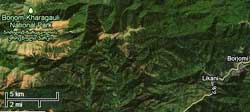
|
| The Borjomi-Kharagauli National Park
is part of the lesser Caucasus. It is one of the largest
in Europe. |
We
have in two previous articles seen that there have been found
bones of an ancient giant near Borjomi in Georgia estimated
to be 2.50 to 3 meters tall. The expedition filmed their struggle
to reach old ruins of a church in a remote area of a natural
park at the feet of the Caucasus Mountains. They had heard
the old stories of "the valley of the giants" and
after a week the group of 15 people, which included archaeologists,
palaeontologists and historians,
got the reward:
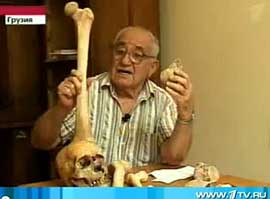 |
|
Prof.
Vekua with bones
|
Giant
bones.
The
renowned professor Abesalom Vekua believes that the find may
be a sensation, and in the news story on the Russian Channel
One he shows the bones and confirms that they it differs from
the bones of modern man in size and thickness: "They
are mentioned as giants in the scientific literature, although
this hypothesis was not confirmed", he said.
A
look at the country of Georgia:
Georgia
is a sovereign state in the
 |
|
Georgia
- between the seas.
|
Caucasus
region of Eurasia, it covers
a territory of 69,700 km² and
the population is almost 4.7 million. Much of the ancient
history of the Caucasus region remains a mystery, simply because
relatively little field research has been done because the
remote
locations. Megalithic
structures are found all over the region and many sites have
similarities with other, better-known megalithic structures
 |
|
Simular
to walls in Peru!
|
around
the world such as the ones at Stonehenge, Malta,
Tiahuanaco or Baalbek.
On the slopes of the Trialeti mountain
range, at an altitude of 1600 metres, cyclopean castles and
menhirs dating back to the 2nd and 1st millennium BC extend
for tens of kilometres. Near the village of
Tejisi there is
a 5 metre high menhir, incorporated into a medieval church
complex, that
is ideally shaped
 |
|
Menhir
|
with
a flat front and rounded
back,
and seems be emitting some sort of radiation. Near Lake Paravani,
in the region of Akhalkalaki, there is a megalithic fortress
at an altitude of 2752 metres. There is another site called
Gochnaris Lodovani ("great rocks of Gochnari") near
the town of Manglisi, in the Algeti river valley. Yet another
megalithic fortress is located
at an altitude of 2800 metres in the Eastern Georgian province
of Kakheti, near the village of Patara Abuli. These cyclopic
structures are built with huge basalt blocks, some of them
4 metres long. The gates seem too big for humans, and walls
are estimated to have been up to 10 metres high.
Approximately
3.000 dolmen are known in the Western Caucasus, and more are
constantly
being found. These dolmen
 |
|
Dolmen,
Georgia
|
are
still of an unknown origin.The dolmens of Abkhazia is typically
consisting of four upright stones and a capstone, some of
them weighting as much as 50 tonnes.
Like
in similar places around the world, the people living there
today cannot provide
any serious information
about the civilizations
that lived there before them. Folk
legends
usually refer to gods or giants of the distant past. It is
as if
 |
|
Patara
Abuli, Georgia
|
worldwide
the builders of the megalithic structures disappeared from
the face of the earth.
Queen
Tamar
One
of the most famous historic persons of Georgia was Queen
Tamar
who lived from 1160 to 1113, the period that was
called the "Golden Age" of
 |
|
Tamar
|
Georgia.
She even had the title of "king", so she definitely
ruled the country in her own right. She was of the Bagrationi
dynasty, the ruling family. According to a family legend,
taken down by the 11th century Georgian chronicler Sumbat
Davitis-Dze, and supplied with chronological data much later
by Prince Vakhushti Bagrationi, the ancestors of the dynasty
traced their descent to the
biblical king David and came from Palestine around 530 AD.
Yes, the same David who killed the
giant Goliath
with a stone from his sling! Could
David have been tall himself? Well, the bronze helmet they
tried
to put on the youngster's head before the fight did not fit!
Ethnic
Georgians call themselves Kartvelebi, and
their land Sakartvelo
– meaning
"a place for Kartvelians".
 |
|
Togarmah
and sons
|
According
to the ancient Georgian Chronicles, the ancestor of the Kartvelian
people
was Kartlos,
the great grandson of the Biblical Japheth - Noahs son (Kartlos
was son of Togarmah, son of Gomer, the eldest son of Japeth).
Kartlos should have been "a brave, gigantic man",
"the legendary giant".
Mount
Kazbek is one of
the major mountains of the Caucasus, not too far
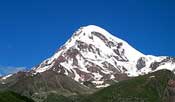 |
|
Mount
Kazbek
|
away
from the Borjomi Gorge. It is associated
in Georgian
folklore with Amirani,
the Georgian version of Prometheus, the titan from Greek mythology,
who was chained on the mountain in punishment for having stolen
fire from the gods and having given
it to mortals.
The legend is traced between 3.000 and 2.000 years BC. The
location of his imprisonment later became the site of an Orthodox
hermitage located in a cave called “Betlemi”
(Bethlehem) at around the 4000 meter level. According to legends,
this cave housed many sacred relics, including biblical Abraham's
tent and the manger of the
infant Jesus.
 |
|
Monastery
Shemokmedi
|
In
the Monastery Shemokmedi in the western Georgian province
of Guria you can find a painting of a sixfingered angel, and
it is said that giants often had six fingers. The site even
predates the monastery's early Christian origins and there
is also "Stone of Giant". According to a legend
a giant used to terrify the village until Saint George was
called to help. He killed the giant, as he had killed the
dragon, and the grateful people erected the church for Saint
George.
 |
|
Statue
of Amirani
|
In
Greek mythology Aeëtes was a King of Colchis, an ancient
Georgian kingdom. Aeëtes was a son of the titan sungod
Helios and Perseis - a daughter of the titan Oceanus. His
daughter Medea, sometimes known as the witch of Colchis, helped
Jason (of Argonaut fame) secure the Golden Fleece. Medea then
fled with Jason. Her son Medeus became the eponymous founder
of the Persians (the people of today's Iran).
An
ancestor of Jesus Christ
According to the gospels of Luke and Matthew, David was an
ancestor of Jesus Christ through both Joseph and Mary. He
is depicted an acclaimed warrior, musician, and poet - and
he is also known for having red hair, based on the description
of his physical appearance as "admoni", 'red-haired',
in 1 Samuel 16-17. He had a fine appearance and handsome features
and his life
is conventionally dated to c. 1040-970 BC.
 |
|
Did
Jesus actually
look like this?
|
Jesus
Christ of the Bible seems to have been as historical person
just as King David - and guess what: Jesus was tall, blond
and had blue eyes! Read the letter from Pontius Pilate to
Tiberius Caesar: "His golden coloured hair and beard
gave to his appearance a celestial aspect." Or the Archko
Volume in The Vatican: "He is the picture of his mother.
His hair is a little more golden than hers. He is tall, and
his shoulders are a little drooped. His eyes are large and
a soft blue."
Yes, let us see what other information we
can find in the Bible and other documents about the family
of Jesus Christ and King David. According to Genesis (and
Ruth), David is the fourth son of the patriarch Jacob of Israel
and ancestor of the tribes of Israel, which were named after
his descendants. He was the grandson of
Abraham. Father Abraham made according to the scriptures a
covenant with God, who promised land and descendants as numerous
as the stars.
A
descendant of Noah's son Shem
Abraham's father Terah was born in Nippur into a priestly-royal
family, but moved later to the ancient city of Ur and then
to Haran that was an ancient city in Upper Mesopotamia and
now a village in Sanliurfa, Turkey. Nippur was one of the
most ancient (some historians date it back to 5262 BC) of
all the Babylonian cities of which we have any knowledge,
the special seat of the worship of the Sumerian god Enlil.
The Sumerian scriptures says that when Enlil saw that the
humans created by his brother Enki were demi-gods, giants,
he decided to kill them by sending a flood.
Christians
believe that Jesus was a descendant of Abraham through Isaac;
Isaac who was saved by an angel when God tested Abrahams faith
by telling him to sacrifice his son on an altar. Abraham was
a descendant of Noah's son, Shem. Noah of the Great Flood
had three sons, Shem, Ham and Japheth.
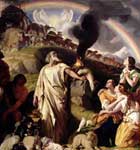 |
|
Noah
has landed
|
We all know the biblical story about Noah and the Ark: God
sees that the man he has created has become wicked and decided
to send a great flood to cleanse the Earth. But God changed
his mind a bit and told Noah to build a large ark. When Noah,
his family and all the animals are safe on board, God sends
the Flood, which rises until all the mountains are covered
and all life on Earth is destroyed. According to the Bible
the ark came to rest on one of the tops of the mountains of
Ararat in present-day Turkey. Noah and his family were safe
and could start to repopulate the Earth.
Sons
of God
So what has all this to do with giants and human archaic species
of Georgia? Well, we have seen that there might be a link
between the ruling family of Georgia and Noah of the Great
Flood. As the scriptures says: "There were giants in
the earth in those days, when the sons of God came in unto
the daughters of men, and they bare children to them".
Some biblical literalists say that the ones that God wanted
to cleanse from the Earth with the Great Flood were the children
that his sons had with the humans; the giants!
 |
|
King
Og's bed
|
So
let us say that the giants were wiped from the Earth by the
great flood but obviously a few of them survived. Some says
they one of the women aboard the ark already was pregnant
with a giant - it could even have been Noah's wife, as some
speculate! The giants blood-line survived through the great
flood, and was brought to what was supposed to be a giant-free
Earth! A Jewish legend tells that the giant King Og begged
and prayed to Noah to come aboard the ark, and that Noah made
an agreement with him that the could sit on the back of an
giant unicorn that was tied to the outside of the ark since
there was not enough room inside for it. Og was the king of
the Amorites, described in Genesis 10:16 as descendants of
Canaan, son of Ham (son of Noah). They are described as a
powerful people of great stature "like the height of
the cedars," who had occupied the land east and west
of the Jordan. King Og is being described as the last "of
the remnant of the Rephaim" - the giants.
 |
|
The
Ark?
|
No
physical evidence
The scientists doubt that the story from the Bible about Noah
and the flood has anything to do with reality, and say that
no physical evidence of the ark has been found. Well, there
are hundreds
of very simular flood stories
all over the world.
In several of them you even find a
name simular to Noah (like Nuu in Hawaii) even if they were
 |
|
Seashells Titicaca
|
written
on a place and at a time that they had no chance to have heard
the Christian version! Sea shell fossils have been found on
mountain tops all over the
world. Lake Titicaca on the border of Peru and Bolivia is
3,811 m (12,500 ft) above sea level, and there
is evidence that it was once a saltwater sea. Its shoreline
is littered with millions
of fossilized seashells, and the marine
fishes and seahorses in the lake are all oceanic types
found only in salt water.
Some researchers are convinced that ruins of what
 |
|
Wharf? Tiwanaku
|
have
been gigantic
stone wharfs once lay at sea level, and that a enormous catastrophe
once folded the land up to make the Andes mountains.
Myself
I was stunned on
a flight from Bangkok
in Thailand to Oslo
in Norway and
happened to look out of the window when we flew across Turkmenistan
on the eastern side of the Caspian Sea: A large area was dotted
with
lakes and hills that look exactly like it
 |
|
Turkmenistan
lakes
|
had
been washed over by gigantic waves!
When it comes to the ark: Mount Ararat
is a prohibited military zone, so no foreigner is usually
allowed to enter the area. Some say that a piece of 5000 year
old wood has been found and that American researchers discovered
a metal trestle under the earth, 137 metres long and 23 metres
wide, which corresponds exactly to the dimensions of the Ark
given to
Noah in the Bible.
 |
|
Scythian
warriors
|
A
race of superb horsemen
Before we leave our "bible studies" we have to look
a bit more at Noah and his family: Magog is the second of
the seven sons of Japheth, one of Noah's three sons, as mentioned
in Genesis.
The territory allotted to Magog after
the Flood was the region north and east of the Caucasus, what
is now southern Russia and the Central Asian republics. His
descendants were by the Greek referred to as "Scythians".
 |
|
Ukraine
stelae
|
Gomer
was Japeth's eldest son, and it has been debated what land
he and his ancestors populated. According to the Greek historian
Herodotus, of the 5th century BC, the Gomerians/ Cimmerians
inhabited the region north of the Caucasus and the Black Sea
during the 8-7th century BC, in what is now Ukraine and Russia.
Some stone stelae found in Ukraine and the northern Caucasus
have been connected with the Cimmerians, and they are in a
style clearly different from both the later Scythians.
Military intelligence reports to the assyrian
king Sargon in the 8th century BC describe the Cimmerians
as occupying territory south of the Black Sea, while the 1st-century
Romano-Jewish historian Josephus placed Gomer and the "Gomerites"
in ancient Galatia - an area in the highlands of central Anatolia
in modern Turkey. Other historians believe that Galatia was
named for the immigrant Gauls (Celts) from Thrace who settled
here and
| The native name for Georgia is Sakartvelo, named
after the ancient Georgian tribe Kartli. Georgia has
been inhabited since the Paleolithic Age. The earliest
remains of human ancestors outside of Africa were unearthed
at the Dmanisi archaeological site, which dates from
approximately 1.8 million years ago. The site has yielded
some of the earliest tools associated with human ancestors.
Later prehistoric remains (Paleolithic, Mesolithic,
and Neolithic) have been discovered in numerous caves
and open-air sites in Georgia. |
became
its ruling caste in the 3rd century BC (yes, we still remember
the Greek myth about
the hundred Thracian giants who waged war on the gods!)
The Scythians were a race of superb
horsemen and archers, and they some researchers believe that
they forced the Gomerians to emigrate into Europe around 700
BC even as far as Ireland - yes, possibly as far as North
America!
The Kurgans
were quite literally the original Caucasians, having originated
from the area around the Caucasus from which the term has
derived - almost 1000 years before the Schytians (even if
the Scythians can be said to be Kurgans, if I understand the
scientists corrects). They were tall, blonde-haired and blue-eyed,
expert horsemen and chariot riders They buried their dead
in large burial mounds , the term kurgan means "burial
mound".
Meshech was another son of Japeth.
He is named with his brother Tubal as principalities of Gog,
prince of Magog. Yes, Magog is in the Book of Ezekiel a place
and not an individual: - Son of man, direct your face towards
Gog, of the land of Magog, the prince, leader of Meshech and
Tubal.
Evil darkness of the north
So who was Gog? It is hard to find any reference to Gog in
the ancient writings besides the Book of Ezekiel. Here "Gog
from Magog" is considered to be a symbol of the evil
darkness of the north, a king that should come from the East
and make war with Israel. Ezekiel also mention that Gog is
the ally of Gomer, Japeths oldests son.
Aurelius Ambrosius (better known
as Saint Ambrose 340-397AD), was a bishop of Milan and he
claimed that Gog was a name for the Goths. The Goths were
according to some scholars an East Germanic tribe of Scandinavian
(Denmark, Norway, Sweden) origin but the ancient Greeks considered
the Goths to be Scythians (Herodotus 440 B.C.) .
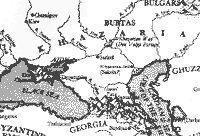 |
|
Map of Khazaria
|
Gog and Magog became by some other ancient scholars identified
with the Khazars, whose empire dominated Central Asia in the
9th and 10th centuries. So did also a Georgian tradition,
which called them "wild men with hideous faces and the
manners of wild beasts, eaters of blood". King Joseph
of Khazaria claimed to be a descendant of Magog's nephew Togarmah.
The ancient Khazar Empire was a major but now almost forgotten
power in Eastern Europe, which in 740 AD converted to Judaism.
It was finally wiped out by the forces of Genghis Khan of
the Mongol Empire, but some evidence indicates that the Khazars
migrated to Poland and formed the cradle of Western (Ashkenazim)
Jewry.
 |
|
Girl from Caucasus
|
It
is said that Kazaria was divided between Ak-Khazars ("White
Khazars") and Kara-Khazars ("Black Khazars").
The Arab writer Istakhri claimed that the White Khazars were
strikingly handsome with reddish hair, white skin and blue
eyes while the Black Khazars were swarthy verging on deep
black as if they were some kind of Indian.
One
Christian schoolar identified two of Magog's sons as Suenno,
progenitor of the Swedes, and Gog (also known as Gethar or
Gogus) as the ancestor of the Goths. Another historian asserted
that Meshech, another of Japeths sons, first ruled also in
Britain.
The Georigian people have traditions
that they, and other Caucasus people, as well as Armenians,
share descent from Meshech.
 |
|
Gog and Mag parade.
|
Guardians
of London
According to the tradition, the giants Gog and Magog are guardians
of the City of London, and images of them have been carried
in the Lord Mayor's Show the second Saturday of November since
the days of King Henry V. The story is that the Roman Emperor
Diocletian had thirty-three wicked daughters. He found thirty
three husbands for them to curb their wicked ways; they chafed
at this, and under the leadership of the eldest sister, Alba,
they murdered them. For this crime, they were set adrift at
sea; they were washed ashore on a windswept island, which
after Alba was called Albion (the oldest name of Great Britain).
Here they coupled with demons and gave birth to a race of
giants, among whose descendants were Gog and Magog. Another
version of the story has it that these two giants were the
last two survivors of the sons of the infamous daughters,
who were captured and kept chained to the gates of a palace
on the site of Guildhall to act as guardians.
 |
|
Nippur
|
Any
truth to the Bible?
We have seen how the ruling family of Georgia seems to be
related to persons of the Bible - from Noah to Jesus. But
is there any truth to the Christian Bible or is it just folklore
and religious rhetoric as some believe? Well, there exist,
as we have seen, historical documents going all the way back
to the time of Jesus - and even before. The "Dead Sea
Scrolls" is a collection of 972 texts from the Hebrew
Bible and extra-biblical documents found between 1947 and
1956 in 11 caves on the northwest shore of the Dead Sea. These
manuscripts date between 150BC and 70AC and confirmed the
integrity of the Hebrew Bible. Before this discovery, the
earliest extant manuscripts of the Old Testament were in Greek
in manuscripts such as Codex Vaticanus Graecus 1209 and Codex
Sinaiticus.
In the early 1900s, German excavators
mapped the ancient Babylon and found that it closely corresponded
to the biblical description. Other archeologcal findings has
long confirmed other great cities mentioned in the Bible,
including the ancient Assyrian capital, Nineveh. Egyptian
history and culture generally matched the biblical accounts.
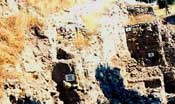 |
|
Troy
excavations
|
When
it comes to the Greek myths and ancient scriptures so is it
quite astonishing to learn they also in correspond with the
Biblical scriptures in many cases - and that the ancient Greeks
believed their myths to be true is well documented. A major
work of Greek mythology was the Iliad by Homer, which is an
account of the Trojan war. Up until quite recent times most
people accepted that it was a work of complete fiction. But
in the 1870s the German archaeologist Heinrich Schliemann
excavated the area and found the remains of Troy - and also
the ruins of King Minos' palace has been found.
 |
|
Confirming the Bible
|
British
Museum
The Sumerians were, as we have mentioned, one of the earliest
societies to emerge in the world, in Mesopotamia. They developed
a writing system known as cuneiform, written on wet clay with
a sharpened stick, or stylus. British Museum holds a collection
of 130,000 cuneiform tablets, dating back 5,000 years. Over
thousands of years Sumerian scribes recorded daily events,
trade, astronomy, and literature on clay tablets. Recently
Michael Jursa, a professor from Vienna, was searching these
tablets for Babylonian financial accounts. Suddenly he came
across a name he half remembered - Nabu-sharrussu-ukin, described
there in a hand 2,500 years old, as "the chief eunuch"
of Nebuchadnezzar II, king of Babylon. This was another discovery
that supports the view that the more historical books of the
Old Testament are based on facts.
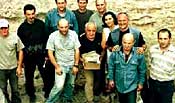 |
|
Vekua and the team
|
Challenges
the "Out-of-Africa" theory
Back to human ancient bones in Georgia; Professor Abesalom
Vekua explains in the Russian tv-news-story that the Borjomi-bones
are larger and more robust that those of homo sapiens, and
he is not unfamiliar with doing sensational archaeological
findings. In 1983, while excavating the remains of a 1,000-year-old
castle in Dmanisi, Vekua and a team member from the Georgian
State Museum found a tooth of a rhinoceros, an odd creature
to have been wandering the Caucasus Mountains. Speculation
about what lay in the sediments beneath the castle spurred
further excavations. Stone tools recovered in 1984 and two
skulls discovered in 1999 were all dated to 1.8 million years
ago, making the site a
 |
|
Dmanisi skull
|
rare
treasure trove for scientists interested in human evolution.
Later four fossil skeletons were found. Most scientists consider
the Georgian Homo erectus georgicus to be a subgroup of Homo
erectus. No-one would have expected to find such fossils outside
Africa, so the Dmanisi-fossils can hardly help but cause a
re-evaluation of current scenarios about human evolution and
migration: They, included a very well preserved skull fossil,
challenges the "Out-of-Africa" theory!
Surviving
specimens of Homo Erectus
Some
scientists say that the so called "Almas" are a
relict population of Neanderthals or surviving specimens of
Homo Erectus. They have been connected to the Denisova Hominina
found in Siberia and to the Yeti of the Himalayas. Stories
and reports dating from the last fifty years have located
the almas community around the Caucasus mountains near Russia
and the Black Sea. "Almas" is mongolian for "wild
man". The plural term almasty is derived from Russian,
while other variations of the name are almasti, almaslar,
bnahua, and ochokochi, which translates as the name for a
forest deity in the West Asian regions, such as Armenia and
Georgia. Almases are most often described as
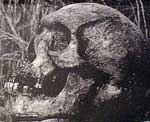 |
|
Skull of Zana's son
|
human-like
animals,
between five and six and a half feet tall (the male often
much taller), their bodies covered
with reddish-brown
hair, with facial features including a pronounced browridge,
flat nose, and a weak chin. Some almases have reportedly been
captured, and most famous was a
wildwoman named Zana. She was captured in the mountains in
1850 and lived in the isolated village of T'khina fifty miles
from Sukhumi. Zana gave birth to a number of children of as
good as normal human appearance but several of these children
died in infancy.
Skeletons
of giants
The
earliest mentioning of giants in Georgia dates back to early
1900's - at the time a part of the Russian Empire. Some boys
discovered a cave full of humanoid skeletons. To get to the
cave, they had to dive into a lake. Each skeleton was about
three meters tall.
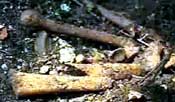 |
|
Borjomi bones
|
Some
say on the internet that a four-meter human skeleton was found
by two amateur archaeologist in Georgia near the village of
Udabno in the summer of the year 2000 and that skeletons of
giants were found at a cave near Gora Kazbek in the 1920's.
I am now trying to get this confirmed - or debunked (there
are a lot of caves around Udabno and Kazbek is the mountain
where according to the myths the Georgian titan Amirani was
chained and you can find the cave that housed Abraham's tent
and the manger of Jesus, as I have described earlier).
 |
|
King Arthur
|
Huge,
tall people
"The Narts were a tribe of heroes. They were huge, tall
people"; so you can read in the Nart sagas, a series
of tales originating from the North Caucasus. They form the
basic mythology of the tribes in the area, including Abazin,
Abkhaz, Circassian, Ossetian, Karachay-Balkar and Chechen-Ingush
folklore. Yes, the Narts themselves are a race of giants and
heroes and some motifs in the sagas are shared by Greek mythology
- like the mentionerd story of Prometheus chained to Mount
Kazbek (or Mount Elbrus) and the myth of Jason and the Golden
Fleece (in which Colchis is generally accepted to have been
part of modern-day Georgia). Some believe that many aspects
of the legends about King Arthur are derived from the Nart
sagas, like the one where Arthur kills a giant living on a
mountain.
In the Georgian myths you can also read
about the "Devi", giants, usually believed to be
evil beings. The devis lived in the underworld or remote mountains,
where they hoarded treasures and kept captives. The myths
usually depicted a family of devis, with nine brothers being
an average numbers. Bakbak-Devi was most often the strongest
and most powerful of the devis.
Human evolution
 |
|
Gigantopithecus
|
If
we look at human evolution from a purely scientific view then
the accepted theory is that there were no giants in our earliest
history, not in Georgia nor any other place on our planet.
But renowned professor Lee Berger says that there has been
a period of gigantism and as we have seen: He has bones to
prove it! Also the German anatomist Franz Weidenreich came
up with the notion that there had been a period of gigantism
in human evolution, and that modern humans were the diminutive
descendants of these giants. He argued that the Gigantopithecus
teeth were human-like, and that it had been a member of the
human family tree rather than an extinct ape. Gigantopithecus
Blacki is by most scientists considered to be the largest
ape that has ever lived, up to 3 metres (9.8 ft) tall, and
weighing up to 540 kilograms (1,200 lb). Some scientists believe
that the almas, the "wild people" of the Caucasus
mountains to be the descendants of tall Homo Erectus, while
Lee Berger consider the giants of South Africa to be tall
Homo Heidelbergensis.
 |
|
Ardipithecus Ramidus
|
 |
|
Homo Erectus
|
Fallen
angels
It
seems that something strange must have happened in the earliest
human history. We "suddenly" changed from being
small apes with small brains to walking hominids of about
the same size as we have today - with about the same brain-size.
Most scientists claim that this is a natural evolution but
some ask how the size of the brain can be doubled in what
seems to be one step; they say that the change is too big.
So
who or what can behind this change if not a natural evolution?
Traditional biblical scholars will say that God created apes
and humans - not apes that turned into humans: That Genesis
tells us that God created Adam, the first human, from the
dust of the ground and then he created Eve from one of Adam's
ribs so that Adam not should be alone. And that we humans
of course are the decendants of Adam and Eve - that they were
created the way we look today. But we also remember that Genesis
tells that the sons of God (or more correct; "Gods"
in plural) found the human females pleasing and had children
with them. Some believe the sons of God were that same as
the "fallen angels"/"watchers" who according
to the scriptures had come down from heaven to Earth. That
they gave rise to a race of hybrids known as the Nephilim;
giants so tall that "the Hebrews were like grasshoppers
in comparison." Most traditional Christian scholars believe
them to have been powerful demons but others believe that
they, like Goliath and his brothers, just were tall misfits
with bad habits; Rebellious misfits that God sent the great
flood to eradicate.
 |
|
Enki creates a human
|
Genetically
manipulated
The
Sumerians developed one of the earliest civilizations on earth,
from the 4th millennium BC - in the area that now is southern
Iraq but before was known as Mesopotamia. Their creation myth
is very simular to the one of the Christian bible; Their gods
created the world with sky, water, animals and humans.
 |
|
Gilgamesh
|
In
the Bible the humans are made from dust, in
the Sumerian texts they are formed from clay. In both the
Bible and the Sumerian texts the humans
are created in the image of the god(s). Also the sons of the
Sumerian gods
begot children with the humans, and also their offspring were
giants - like Gilgamesh.
Some of the ancient Sumerian clay
tables depicting the creation of the human race show the struggle
their gods seems to have trying to make the humans; it seems
to have been an intricate process. Some says that this creation
process in facts was a medical experiment, where aliens from
the stars (the Sumerian texts say that their gods came from
the stars) created humans that they could use as their servants
(or slaves if you like; Zecharia Sitchin claimed that the
texts reveals that the humans were created by Anunnaki from
the planet Nibiru to work in gold mines); that the tablets
show that instruments and medication were used.
So
if there is something true to the oldest creation tale; might
be the archaic homo species, like Homo Neanderthal, Homo Erectus,
Homo Heidelbergensis and Cro-Magnon were genetically manipulated
existing animal species like apes?
Died
out
Also the ancient Sumerians had stories of a great flood. Their
supreme god Enlil wanted the mankind to vanish (might be because
they became to many and/or powerful), but the god Enki who
had been responsible for creating the humans warns the hero
Ziusudra (Atrahasis/ Utnapishtim) and gives him instructions
on building an ark.
So - according to the Christian bible, the
Sumerian tablets and simular flood stories all over the world,
the human race more or less was wiped out in worldwide flood.
Only a few survived and started repopulating the earth.
 |
|
Skull from Nazca, Peru
|
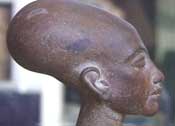 |
|
Daughter of pharaoh
|
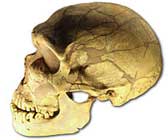 |
|
Homo neanderthalensis
|
Traditional
scientists will tell you that there was no worldwide flood;
only local floods caused by the melting ice at the end of
the last ice-age about 10.000 years ago. Well, a world wide
flood or not; Advanced
civilisations appeared almost instantly all over the world.
The European explorers that came hundreds of years later heard
that native people have had assistance: Human looking "gods"
had
helped them to develop agriculture, husbandry, written language,
mathematics and science. Yes, very tall, white skinned, blonde
and blue-eyed gods came, helped - and left. And then the highly
advanced
civilisations deteriorated so fast and completely that only
the buildings and the memories were left.
Well, might be the gigantic visitors
left more than memories, because very unusual skulls have
been found all over the world where advanced civilisations
once have existed. Elongated, large skulls have been found
in Bolivia, Peru, Mexico, Egypt and other places where advanced
civilisations once existed.
The biggest change from being apes
to humans must be the skulls - we have much bigger brains.
But surprisingly enough; Homo neanderthalensis, that lived
600.000-20.000 years ago, had a bigger brain than we have
today. Their skulls were not as elongated as the skulls of
the Egyptian pharaoh Akhenaten, his daughters and his wife
Nefertiti (and Tutankhamen) but there is a clear resemblance.
And we also know that the pharaoh Ramses II was a very tall
man that had a Nordic appearance - even blond hair. Yes, many
of the pharaohs and their relatives had blond hair and light
skin, as we can see on wall paintings and also their mummies.
Remains
of the legendary Atlantis
 |
|
Skull from Caucasus
|
But
they have not found any elongated skulls in Georgia? No, not
yet. But they have quite recently found elongated skulls in
the north Caucasus mountains, not far away at all!
According to the ancient Greek historian
Herodotus (circa 484 - 425BC), Egyptians occupied the area
of Colchis at the eastern end of the Black Sea. Herodotus
states that these Egyptians knew more about Egyptian history
than the Egyptians themselves. Apollonius of Rhodes, who lived
some years later, states that the Egyptians of Colchis preserved
as heirlooms a number of wooden tablets showing seas and highways
with considerable accuracy. The kingdom of Colchis, which
existed from the sixth to the first centuries BCE, is regarded
as the first Georgian state. Some believe that secret tablets
have revealed that the Colchis was built on the remains of
the legendary Atlantis. Well, the only source we have of Atlantis
is the Greek writer Platon, who in about 360
BC mentioned in his writings a story from his ancestor Solon.
While visiting the priests of Sais in Egypt,
the Athenian statesman, lawmaker, and poet Solon (638 BC -
558 BC) learned the
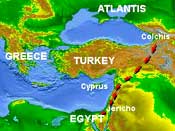 |
|
The migration route
|
story
of a magnificent ancient civilization that disappeared 9.000
years earlier, that
great earthquakes and floods had destroyed Atlantis (the name
should have been made up later, and it has nothing to do with
the Atlantic Ocean - and The Pillars of Heracles was not Gibraltar
but the Bosporus Strait!). The surviving Atlanteans had fled
to the southwest and finally reached the fertile soil and
mild climate of Egypt. Some of the mountain villages in Colchis
should have been relatively untouched by the cataclysmic disaster,
and that is why the ancient Greek historians talk about Egyptians
in what today
is Georgia - they were the pro-Egyptians!
 |
|
Gold necklace from Colchis
|
Golden
Fleece
There seems to have been a ancient link between Georgia and
Egypt, and there definitely was a link to Greece. The Greek
historians of the ancient times had as we have seen an intriguing
knowledge about the country they called Colchis, and ancient
Greek legends told of a fabulously wealthy land where Jason
and the Argonauts stole the Golden Fleece from King Aeetes
with the help of his daughter Medea. The Golden Fleece was
the fleece of the gold-haired, winged ram. Well, the ancient
Greeks referred to Colchis as "polychrysos", meaning
"rich in gold" and it is a fact that gold have been
mined in Georgia and that the country today represents an
extremely prospective region for gold deposits! It was said
that gold was carried down by the mountain torrents, and that
it in ancient times was obtained by means of perforated troughs
and fleecy skins! Golden Fleece - but not on a living ram!
Did
I forget to mention that Jason and his brave men had to fight
off a gang of giants before they reached Colchis, with Heracles
killing most of them?
 |
|
Prometheus
|
Armour
and spears
The giants of the earliest Greek legends were nothing like
the stupid trolls of the Nordic myths - they were represented
in human form and equipped with armour and spears.
The ancient Greek believed that their legends were true -
that the gods, giants and heroes had lived. So many of the
Georgian legends are so simular to the Greek that there must
be a link, there must be something true to the basics of the
legends! And it is quite strange that so many of their legends
include Colchis and the Caucasus mountains. Why should Prometheus,
the titan from Greek mythology, be chained to a mountain in
Georgia? Would it not be more natural that the gods chained
him to Mount Olympus? Not only is it the tallest mountain
in Greece but it was here the ancient gods lived! Also where
the gods were attacked by 24 giants, quite successfully until
the god Heracles immobilized the leader of the giants by tossing
him over his broad shoulders, and rushing him over the Thracian
border. Yes, the giant was sent back to where he
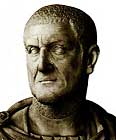 |
|
Maximinus
Thrax
|
came
from but history does not really give clear information on
where Thracia was situated but it was someplace to the north
or northeast. In one ancient Greek source, the very Earth
is divided into "Asia,
Libya, Europa and Thracia".
Another giant from Trachia was Maximinus Thrax - and we know
that he was real. His name can be translated to "The
Giant from Thracia" and he was Roman Emporor from year
173 to 238. According to Historia Augusta, "he was of
such size, so Cordus reports, that men said he was eight foot,
six inches in height". We do have busts and coins showing
Maximinus with his prominent brow, nose and jaw but if he
really was 2.60 tall is hard to tell.
 |
|
Kon-Tiki
|
Stolen
the Odin-name
Norwegian Thor Heyerdahl often emphasized that the legends
often were the older days' history books, and many of his
archaeological findings were done by studying the legends.
Yes, he regret that he had not studied the ancient texts even
better before he sailed off into the Pacific in the Kon-Tiki
raft, for later tests showed that the ancient centreboards,
guaras, that he had seen on old drawings were much more fit
to
 |
|
Heyerdahl
|
navigate
a raft than the long steering-oar they used!
I
do not think that Thor Heyerdahl ever motioned human giants
in his books or research papers but for a more that 60 years
he tried to figure out who the tall, white "gods"
that in pre-history travelled the world were. The research
led him across many oceans and from country to country. And
it finally brought him to Azov in Russia, just north of Georgia
and the Caucasus
mountains! The Norwegian Viking kings bragged that they were
descendants of a god named Odin.
 |
|
Ganger-Rolv
|
Heyerdahl
believed that this Odin was
a chief that had emigrated from the area around the river
Don at the time of the
Roman expansion - to escape the Roman soldiers. He had stolen
the Odin-name to impress the local people! Well, the Norwegian
Viking kings were tall - often very tall - and blonde, at
a time where few people in Norway were tall and blond. Could
this Odin be a giant from the Caucasus-mountains?
Systematic
expedition and research
Back
to the findings of Georgia:
 |
|
Otar Bagaturia
|
One
of the members of the expedition to find
the giant bones of Borjomi was Dr. Otar Bagaturia, a senior
lecturer in Political Science, Department of Public Administration
at Georgian Technical University (Tbilisi, Georgia). Here
is what he has been writing in e-mail to me:
"There is no systematic research
in Georgia in this field, but it is discussed to whom and
to which era these bones belongs:
- early Christian era, because there is used Roman concrete
for church and may be for crypt very close to this church,
where these bones were found, and so the bones could belong
to ancient human, may be to christian Georgians.
-
These bones are from prehistoric era and belong to some specific
race of prehistoric human.
| You find legends of a very tall, white, blond
and blue-eyed god or god-man all over the world. The
Aztec, Maya and Inca call him Quetzalcoatl, Kukulkan
and Viracocha, respectively. He came, helped the people
and left - and is thought to return. Some believe that
the Maya legends tell that he will return on the 21
December 2012. They do not say in what form he will
return, though. Might be DNA-testing of ancient bones
of what we call giants will make him "come alive"
so that the scientists can tell his intriguing story
and make the world wake up to a new reality? |
-
Or may be for some kind of "Gigantopithec" (gigantic
Ape or Anthropoid)
Yes, we found them (the bones) in the crypt but may be thees
bones were found by builders of the church and regraved
but that the owners of these bones died much more earlier.
These church, crypt and road stones are not Megalithic,
but generally in Georgia and also around it, in this specific
area, are huge stones which may be are waste of Megalithic
age."
Baghaturia
explains that they have not found somebody who could arrange
a systematic expedition and research, and that some members
of the group are sceptic to allow others in on the research.
He is anyway hoping that a new expedition can be made and
also that they could find equipment to do proper dating
of the bones.
So
many questions
There are so many questions to be answered but at least
we have seem that there is a link between Georgia, the Christian
Bible, the Greek Legends, ancient kingdoms and very tall
people. Yes, there even is a link between archaic humans
and Georgia. And interesting enough; It seems that the Caucasus
Mountains in one way or another is at the centre of it all.
In the next article we will
go to the other side of the Caucasus mountains to take a
close look at the fossilized bones that were excavated in
Denisova Cave in Altai Krai, Russia - among them a tooth
larger than any human bone previously found!
Terje
Dahl
(See
additions from the editor
further down. The article about the giant bones in the Denisova
cave is now completed - click here)
What
do you think?
Do
you have any ideas, thoughts or facts - please send them
to Terje Dahl: terje@sydhav.no
Here
are the ideas, thoughts and facts our readers have sent in:
The Amorites are the Martu Horsemen [Mara horse} of
the tribe of Tubal as are also the Khazars from the
sons of Kesedim of the sons of Tubal: all tall and blond
men: and their city is Urfed of the Kesedim i Anatolia.
And as where Abraham came from Ur of Mesopotamia was
added into the picture after it modern discovery by
the scholar: old scholars; knew that it was the Ur in
Anatolia.. I have more information if you would like:
fafdc51@gmail.com
or on Facebook under my name?
Frank
A Fontana DC
Giants of Georgia's Borjomi valley
In my opinion after watching the science tv channel
re the giant bones found and then stolen after the death
of the scientist who found them to stop in my opinion
the news getting out as to what and who these people
are or were...
In my opinion they are the
BIG FOOT (yeti) that so many siting's from people who
have seen them alive and well... Please do not respond
as I do not want any spam coming back to me either so
I will delete this after I send you a copy. I just want
people to stop calling them giant people as they are
the Big Foot that so many have seen still walking around
today
Thanks!
Carol Berger
I found your article very interesting .. thank you ..
I have been following the idea of giants nephilim etc
for a while now and have noticed a couple of things
.. the description of these giants tends to be fair
or red hair blue or green eyes pale etc shining ones
as they have been termed , all of which in modern times
we associate with Scandinavians .. the areas (in the
mid east) where these legends occur tend to be areas
tend to be areas that have haplogroup J2 present ..
Cro-Magnons were in-correctly thought to be haplogroup
R1B/A for a long time but now it is known that actually
Cro-Magnons were haplogroup I which is way downstream
from F ... haplogroups I and J both stem from the same
supergroup called IJ which was in the middle east (don't
forget the mid east at these time was much cooler due
to the ice age , one group moved into Europe and became
I the other stayed in the mid east and mutated into
J however the 2 groups are difficult to distinguish
from each other genetically to this day ..
http://www.eupedia.com/forum/threads/29080-Chronology-of-Cro-Magnon-Y-DNA
I believe that the stereotypical Scandinavian tall pale
etc is the purest look of what these IJ people looked
like ... the far northern sub-group I1 being the most
isolated in the far north of Europe .. the J brother
group that stayed behind found themselves in a more
pleasing climate for others to migrate into after the
melting of the ice age and then came from Africa the
E haplogroup --- Imagine the reaction of these African
pioneers when they came across the original J people
??? very tall Scandinavian appearance ... Over the millennia
since this first contact there would have been embellished
myths about them etc .. over time as the groups merged
they became what we see as middle easterners today ..
both J and E are the highest groups all across the middle
east .. in the far north of this world in the Caucasus
the E migrants would've been less inclined to settle
and here perhaps the last shining ones would've still
maintained their original look.
I don't agree with everything they say in these links
but there are perhaps some grains of truth that can
be picked from them:
http://gianthumanskeletons.blogspot.com.es/2011/10/cro-magnon-giant-race-in-europe.html
http://frontiers-of-anthropology.blogspot.com.es/2011/09/antediluvian-nephilim-giants-of.html
This forum has links within it that talk about IJ haplogroup:
http://www.anthrogenica.com/archive/index.php/t-1605.html
"J-M172 can be classified as Greco-Anatolian,
Mesopotamian and/or Caucasian and is linked to the earliest
indigenous populations of Anatolia. It was carried by
Bronze Age immigrants to Europe, and ultimately descends
from the Cro-Magnon population (IJ-M429 Y-DNA) that
emerged in Southwest Asia around 35,000 years ago."
Wikipedia.org - Haplogroup J2 M172:
http://en.wikipedia.org/wiki/Haplogroup_J-M172_(Y-DNA)
.... I hope you find this subject of interest
I believe you should look into genetics to dig deeper
into the truth .. the majority of paternal (ydna) of
the Caucasus area is J2a and G2a ... the nakh for example
are 89% j2a chechens 56% j2a .. ossetians on the other
hand are higher in g2a but also have j2a .. I think
if you start looking into the ydna then it may help
you .. thanks...
Regards
Alastair
I love your article.
Myah
Thomas
Few short comments: Nephilym (spelling?) was the name
given the spawn of fallen Angels ("the watchers"
according to the book of Enoch) & the daughters
of man. These Nephyllim show up again during Joshua's
time. They can't just be doing the same thing in Joshua's
time that they were doing in Adam's time?. David was
not the grandson of Abraham but Obed, the son of a Moabite
woman not an Amorite woman. Also an Assyrian black obelisk
from the time of the dispersion of the northern Kingdom
of Israel lists the Northern tribes of Israel as the
Sache or Scythians. It also lists that they were relocated
just below the Caucasus mountains. This account is in
keeping with the Biblical account in 2 Chronicles. It
is also in keeping with the Biblical blessing/promises
of their character- good with the bow fierce warriors,
etc. Check out britam.org & missingbibletribes.org.
I fully expect to see more cultic demonic activity of
breeding with the daughters of man. Jesus promises that
before His return it would be as in the days of Noah.
jubileegemstones.org
|
Additions
from the editor:
According
to Wikipedia:
The Trialeti culture, named after Trialeti
region of Georgia, is attributed to the first
part of the 2nd millennium BC. The Trialeti culture
was known for its particular form of burial. The
elite were interred in large, very rich burials
under earth and stone mounds, which sometimes
contained four-wheeled carts. Also there were
many gold objects found in the graves. These gold
objects were similar to those found in Iran and
Iraq. This form of burial in a tumulus or "kurgan",
along with wheeled vehicles, is the same as that
of the Kurgan culture which has been associated
with the speakers of the Proto-Indo-European language.
The Trialeti culture was a second culture to appear
in Georgia, after the the Shulaveri-Shomu culture
which existed from 6000 to 4000 BC. The Trialeti
culture shows close ties with the highly-developed
cultures of the ancient world, particularly
with the Aegean.
Well, the Pit Grave culture for the kurgans is
said to have been around 3000 BC. Take a look
at the gold and jewel amulets that were found
in the graves: I am not sure that we can make
such brilliant artwork with today's modern technology
and instruments! The artefacts were found in large
burial mounds (quite simular to Göbekli Tepe
in Turkey and
also American mounds) but not buried people were
found inside. Nor have the archaeologists found
any settlements after the after the people - and
this is a mystery to them! What if the mounds,
as the pyramids, were mente to be a kind of life-rafts?
Where they made for the kings so that they could
a large catastrophe, like the food of the Bible?
But that the catastrophe struck before they managed
to get the kings inside?
More
history:
At the beginning of the patriarchate of the
land of the Armenians and Georgians and at the
head of our clan was T'orgom. He had eight brave
and gigantic sons. The senior [son] among them
was Hayk; second was K'art'los; third was Bardos;
fourth was Movkan; fifth was Lekan; sixth was
Heros; seventh was Kovkas; and eighth was Egere's.
When T'orgom divided his legacy among his sons,
he gave the land of Armenia, with all [g113]
its borders to Hayk, while [he gave] to K'art'los
and the other brothers the northern Tsmak ("forested")
lands.
Armazi (Georgian: ??????) was, according to
the medieval Georgian chronicles, the supreme
deity in a pre-Christian pantheon of ancient
Georgians of Kartli (Iberia of the Classical
sources). Here
And
more:
Georgian literary tradition credits the first
king of Kartli, Pharnavaz I of Iberia (assumed
to have reigned c. 302-237 BC), with the raising
of the idol Armazi – reputedly named after
him – on a mountain at his capital, and
the construction of a similarly named fortress.
The 9th/10th century hagiographic work Life
of Nino describes the statue of Armazi as "a
man of bronze standing; attached to his body
was a golden suit of chain-armour, on his head
a strong helmet; for eyes he had emeralds and
beryls, in his hands he held a sabre glittering
like lighting, and it turned in his hands."
Here
(So
his eyes must have been blue!)
Gimbutas writes that the people of the Dnieper
Donets Culture were large, strong, and broad-faced
(brachycephalic) descendants of Paleolithic
Cro-Magnon man. This is important.
http://www.lexiline.com/lexiline/lexi142.htm
The early Kurgans appear to have coexisted with
another, more primitive culture, generally referred
to as "Cro-Magnon".
http://www.mysteriousworld.com/Journal/2003/Summer/Giants/
Houston Stewart Chamberlain claimed that King
David and Jesus were both Aryans of Amorite
extraction. This argument was repeated by the
Nazi ideologist Alfred Rosenberg.
http://en.wikipedia.org/wiki/Amorite
The Amorites are mentioned more than 80
times in Scripture, and early on, some were
allied with Abraham (Genesis 14:13). They were
descendants of Noah’s grandson Canaan (Genesis
10:15–16). Although the Bible does not
provide this information, the Jewish general-turned-historian
Josephus gives the name of their ancestor as
Amorreus.1 While the Amorites are mentioned
in the same contexts as other giants a few times,
they are specifically described as giants in
the Minor Prophets.
https://answersingenesis.org/bible-characters/giants-in-the-old-testament/
|
|
|